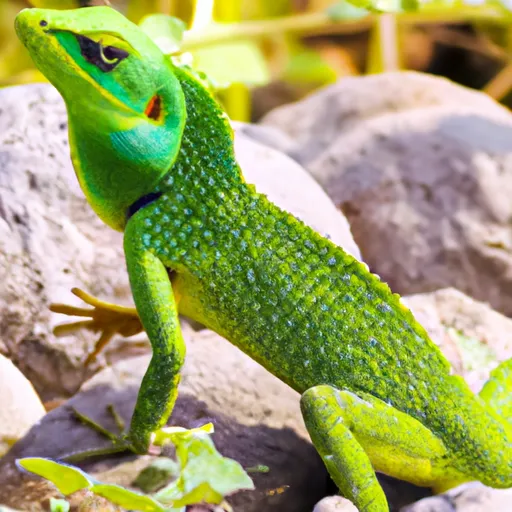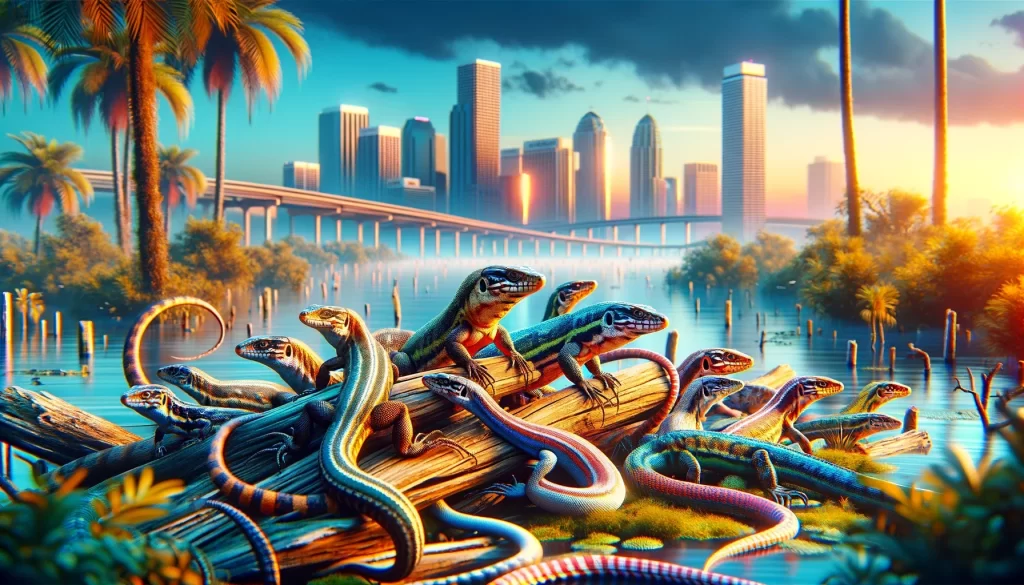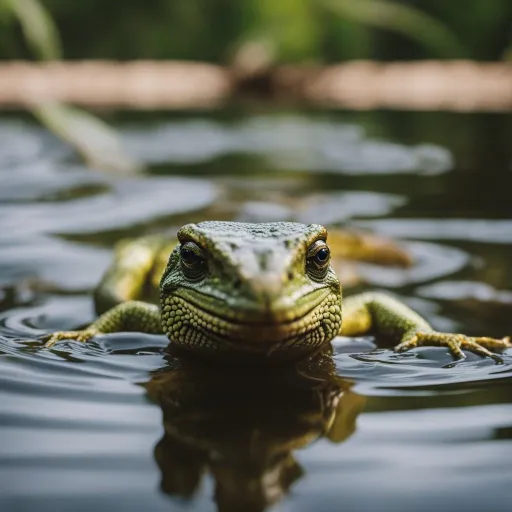So, you’re curious about the lifespan of green lizards, huh? Well, wonder no more! This article will give you all the juicy details on how long these little reptiles can stick around for.
From their vibrant appearance to their intriguing habits, green lizards have always captivated the curious minds of nature enthusiasts.
Whether you’re a lizard lover or simply intrigued by their long-lasting existence, get ready to uncover the secrets of the green lizard’s lifespan.

Overview
Green lizards are a fascinating group of reptiles that inhabit various regions around the world.
With their vibrant green coloration and unique characteristics, they captivate the attention of nature enthusiasts and researchers alike.
Understanding the lifespan of green lizards is crucial in comprehending their ecological role and implementing effective conservation efforts.
In this article, we will explore the definition of green lizards, describe their physical attributes, and discuss the importance of knowing their lifespan.
Definition of Green Lizards
Green lizards, also known as lacertids, are members of the family Lacertidae. They belong to the order Squamata, which comprises reptiles such as lizards and snakes. Green lizards are characterized by their predominantly green coloration, though some species may exhibit variations in shade or even display other hues. They vary in size, with some species reaching lengths of only a few inches, while others can grow up to several feet long. These lizards are ectothermic, meaning they rely on external sources of heat to regulate their body temperature.
Description of Green Lizards
Green lizards possess several distinctive physical attributes that contribute to their overall appearance and functionality. They typically have elongated bodies with slender tails, allowing for swift movements and excellent agility. Their scales are often smooth, contributing to their sleek and streamlined appearance. Many species of green lizards also have the ability to detach their tails as a defense mechanism, which can regrow over time. Additionally, they have well-developed limbs, enabling them to climb trees and navigate challenging terrains with ease.
Importance of Knowing Their Lifespan
Understanding the lifespan of green lizards is crucial for several reasons. Firstly, it provides invaluable insights into their biology and life history. By knowing how long these lizards live, scientists can gain a better understanding of their reproductive patterns, growth rates, and overall population dynamics. This knowledge is particularly important for conservation efforts, as it helps in implementing effective management strategies and protecting their habitats. Moreover, the lifespan of green lizards plays a vital role in understanding their ecological role within their respective ecosystems, including their impacts on prey populations and interactions with other species.
Factors Influencing Lifespan
Several factors influence the lifespan of green lizards, including species, environment, climate, predators, and food availability.
Species
Different species of green lizards exhibit varying lifespans. Some species have shorter lifespans, lasting only a few years, while others can live for several decades. This inter-species variation is attributed to differences in genetic factors and physiological adaptations.
Environment
The environment in which green lizards reside greatly affects their lifespan. Lizards living in habitats with favorable conditions, such as abundant food resources, suitable shelter, and optimal temperatures, tend to have longer lifespans. On the other hand, lizards dwelling in challenging environments may face greater hardships and experience shorter lifespans.
Climate
Climate plays a significant role in determining the lifespan of green lizards. Lizards in regions with mild and stable climates, where they can easily regulate their body temperature, tend to live longer compared to those in regions with extreme temperatures or fluctuations.
Predators
Predation is a major factor influencing the lifespan of green lizards. Lizards that face a higher concentration of natural predators are more likely to have shorter lifespans. Predatory birds, snakes, and mammals pose a constant threat to these reptiles, especially during vulnerable life stages.
Food Availability
The availability of food resources directly impacts the lifespan of green lizards. Lizards with access to a diverse range of prey items, rich in essential nutrients, have better chances of survival and prolonged lifespans. Conversely, a limited food supply can lead to malnutrition, compromising their health and lifespan.
Life Cycle of Green Lizards
The life cycle of green lizards consists of various stages, from hatching to adulthood and reproduction.
Hatching
Green lizards start their life as eggs, usually laid in a secure location such as leaf litter or underground burrows. The incubation period varies between species but generally lasts several weeks to a couple of months. Once the eggs hatch, the newborn lizards emerge and begin their journey into the world.
Juvenile Stage
During the juvenile stage, green lizards go through significant growth and development. They are typically more vulnerable to predation and environmental stresses compared to adults. Juvenile lizards often occupy different habitats than adults, providing them with ample opportunities to grow and acquire the necessary skills for survival.
Adult Stage
Green lizards reach the adult stage when they have attained their full size and are capable of reproduction. This stage is marked by their participation in the adult population, engaging in behaviors such as territoriality and courtship. Adult green lizards exhibit higher resistance to predation and become integral members of their ecosystems.
Reproduction
Reproduction in green lizards varies among species, but most employ sexual reproduction. Male lizards engage in courtship rituals and display vivid coloration to attract potential mates. After mating, females lay eggs and carefully select suitable sites to ensure the survival of their offspring. The reproductive success of green lizards greatly influences their overall lifespan.
Common Species of Green Lizards
There are numerous species of green lizards found across the globe, each with its unique characteristics and ecological niche. Some common examples include the Green Anole, Eastern Fence Lizard, Northern Green Frog, and Green Iguana.
Green Anole
The Green Anole, scientifically known as Anolis carolinensis, is a small lizard native to the southeastern United States. It is known for its vibrant green coloration, but it also has the ability to change its color to brown or gray based on mood, temperature, or social interactions. Green Anoles typically have a lifespan of two to five years in the wild.
Eastern Fence Lizard
The Eastern Fence Lizard, known as Sceloporus undulatus, is commonly found in eastern and central parts of North America. It is characterized by its spiny appearance and ability to flatten its body against surfaces when approached by predators. Eastern Fence Lizards can live up to six years in the wild.
Northern Green Frog
The Northern Green Frog, or Lithobates clamitans, is a species of aquatic frog native to North America. While not a lizard in the strict sense, it is often referred to as a green lizard due to its bright green coloration. These frogs have a lifespan of about six to eight years, although some individuals have been known to live longer.
Green Iguana
The Green Iguana, scientifically named Iguana iguana, is a large lizard found in Central and South America. It is one of the largest species of lizards, with some individuals reaching lengths of over six feet. Green Iguanas have a relatively long lifespan compared to other green lizards, with individuals living up to 15 to 20 years in the wild, and even longer in captivity.
Lifespans of Different Green Lizard Species
The lifespans of green lizard species can vary significantly. Here are the estimated lifespans of some common species:
Green Anole
The Green Anole has a relatively short lifespan compared to other green lizards, typically living for two to five years in the wild.
Eastern Fence Lizard
Eastern Fence Lizards have a slightly longer lifespan, with individuals living up to six years in the wild.
Northern Green Frog
Northern Green Frogs generally live for about six to eight years, although some individuals may live longer.
Green Iguana
Green Iguanas have one of the longest lifespans among green lizards, with individuals living up to 15 to 20 years in the wild.
Determining the Lifespan of Green Lizards
Determining the exact lifespan of green lizards requires careful observation, documentation, and scientific studies. Researchers employ various methods to study the lifespans of these reptiles.
Observation and Documentation
One of the primary methods used to determine the lifespan of green lizards involves long-term field observations. Researchers observe and document individual lizards, noting their birth or hatching dates and tracking their survival throughout their lifespan. These studies provide valuable insights into the life expectancy of different species.
Mark-Recapture Method
The mark-recapture method involves capturing and marking individual green lizards with a unique identifier, such as colored tags or microchips. The lizards are then released back into their natural habitat. Over time, researchers recapture individuals and compare the number of marked individuals to the overall population. This method allows scientists to estimate survival rates and calculate average lifespans.
Captive Studies
Captive studies involve keeping green lizards in controlled environments, such as zoological facilities or research laboratories. By monitoring these lizards under controlled conditions, researchers can eliminate certain variables, such as predation and environmental fluctuations, and obtain more accurate data on lifespan and survival rates.
Longevity Records of Green Lizards
While there is considerable variation in the lifespans of green lizards, some individual lizards have achieved remarkable longevity.
The Oldest Green Lizard Ever Recorded
As of current records, the oldest known green lizard is a Green Anole that lived for an impressive eight years in captivity. This individual, named “Old Greenie,” surpassed the average lifespan of its species by several years, highlighting the potential for extended lifespans under optimal conditions.
Impacts of Lifespan on Green Lizards
The lifespan of green lizards has significant impacts on various ecological aspects and conservation efforts.
Ecological Role
Green lizards play crucial roles within their respective ecosystems. They are both predators and prey, contributing to the balance of their food webs. Their lifespans determine their involvement in these interactions, as they provide stability and continuity to the populations they belong to. By understanding their lifespans, scientists can better comprehend their ecological importance and the potential consequences of population declines.
Conservation Efforts
Knowing the lifespan of green lizards is vital for effective conservation efforts. By monitoring their populations and studying their life histories, conservationists can identify areas of concern, implement protective measures, and restore or create suitable habitats. Additionally, understanding the lifespans of different species helps prioritize conservation efforts and allocate resources accordingly.
Threats to Green Lizards
Several threats pose risks to the survival and lifespans of green lizards.
Habitat Loss
Habitat loss and degradation are significant threats to green lizards. Human activities such as deforestation, urban development, and agriculture result in the destruction and fragmentation of their habitats. Disruption of their natural environment can lead to decreased food availability, reduced reproductive success, and increased susceptibility to predation, ultimately shortening their lifespans.
Climate Change
Climate change presents numerous challenges for green lizards. Rising temperatures can directly impact their physiology and behavior, causing suboptimal conditions and increased risks of heat stress. Climate change can also lead to alterations in their food availability and disrupt crucial breeding and nesting cycles. These factors combined can have detrimental effects on their lifespans.
Invasive Species
Invasive species pose a significant threat to green lizards and their habitats. Non-native predators and competitors can disrupt the balance of ecosystems and outcompete native species. The presence of invasive species can increase predation pressure, reduce the availability of resources, and further jeopardize the survival and lifespans of green lizards.
Conclusion
In conclusion, green lizards are captivating creatures with a wide range of species and varying lifespans.
Understanding their lifespans is essential for unraveling their biology, implementing effective conservation strategies, and appreciating their ecological role.
Factors such as species, environment, climate, predators, and food availability all contribute to the lifespans of green lizards.
By protecting their habitats, mitigating threats, and conducting further research, we can strive to ensure the longevity and survival of these remarkable reptiles for generations to come.



